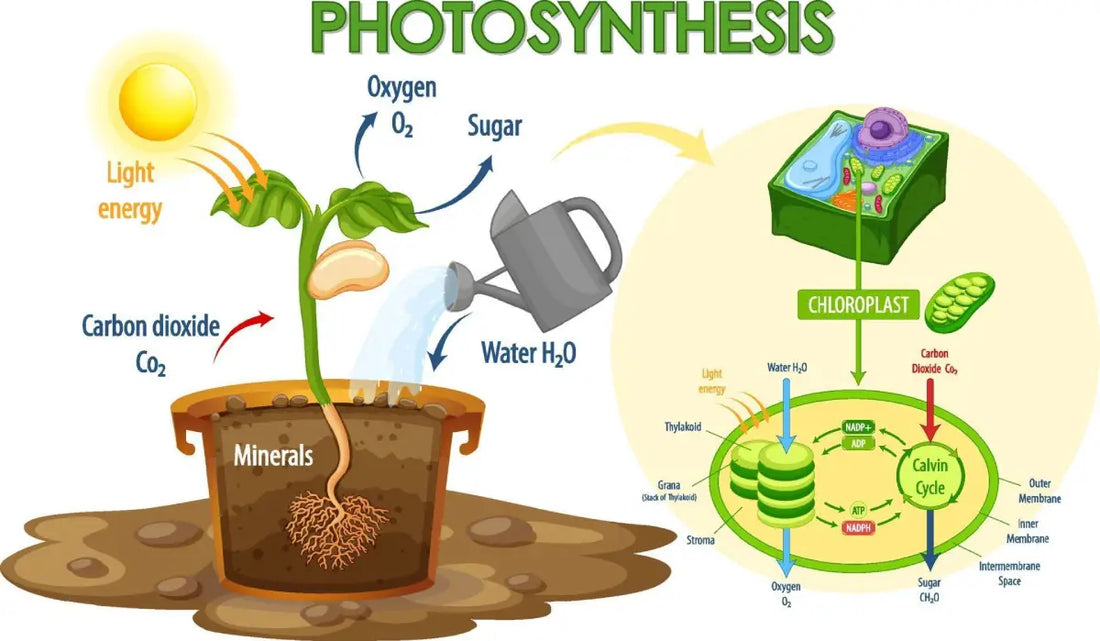
What Part of the Plant Produces Food for the Plant?
The Science Behind Photosynthesis
Plants are remarkable organisms that can produce their own food through a process called **photosynthesis**. But have you ever wondered exactly which part of the plant is responsible for this vital function? The answer lies in the **leaves**, which act as the plant’s primary food producers. In this article, we’ll explore how plants make their food, why leaves play a crucial role in this process, and how high-quality nutrients like **Lotus Nutrients** can enhance plant growth and health.
The Process of Photosynthesis: How Plants Make Their Food
Plants rely on **photosynthesis** to produce food, which provides the energy they need to grow and survive. Photosynthesis is a chemical process that takes place in plant cells, specifically in the **chloroplasts**, which contain a green pigment called **chlorophyll**. Chlorophyll absorbs sunlight and uses its energy to convert **carbon dioxide (CO₂) from the air and water (H₂O) from the soil** into **glucose (C₆H₁₂O₆),** a type of sugar that serves as the plant's primary energy source.
The Photosynthesis Equation:
The chemical equation for photosynthesis is:
6CO₂ + 6H₂O + Light Energy → C₆H₁₂O₆ + 6O₂
This equation shows that plants use carbon dioxide and water, powered by light energy, to create glucose and release oxygen as a byproduct.
Which Part of the Plant Produces Food?
The **leaves** are the main site of food production in plants. They contain specialized cells that house **chloroplasts**, which capture sunlight and convert it into chemical energy. The structure of leaves is perfectly adapted for this function.
1. **Chloroplasts in Leaf Cells**
Chloroplasts are organelles found in plant cells, primarily within the **mesophyll** layer of leaves. These chloroplasts contain **chlorophyll**, the green pigment that absorbs sunlight and plays a key role in photosynthesis.
2. **Stomata for Gas Exchange**
Leaves have tiny openings called **stomata**, which allow carbon dioxide to enter the plant and oxygen to exit. These microscopic pores regulate gas exchange and are essential for the photosynthesis process.
3. **Vascular System (Xylem and Phloem)**
The **xylem and phloem** are transport systems within plants that help distribute water, minerals, and food. The **xylem** carries water from the roots to the leaves, while the **phloem** transports the glucose produced in the leaves to other parts of the plant, including the roots and stems, for growth and storage.
The Role of Lotus Nutrients in Plant Food Production
For plants to efficiently produce food and thrive, they require essential nutrients that support photosynthesis and overall health. **Lotus Nutrients** provides a complete line of plant fertilizers formulated to maximize growth, yield, and vitality.
1. **Nitrogen (N) for Chlorophyll Production**
Nitrogen is a crucial nutrient that promotes the formation of chlorophyll, the pigment responsible for photosynthesis. **Lotus Nutrients Grow Formula** contains the perfect balance of nitrogen to ensure lush, green foliage that efficiently captures sunlight.
2. **Phosphorus (P) for Energy Transfer**
Phosphorus is essential for energy transfer within plant cells. It helps convert light energy into usable chemical energy, ensuring robust growth and strong root development.
3. **Potassium (K) for Water Regulation**
Potassium helps plants regulate water uptake and maintain proper turgor pressure, ensuring that water and nutrients are efficiently transported to the leaves for photosynthesis.
4. **Magnesium (Mg) for Chlorophyll Function**
Magnesium is a key component of chlorophyll molecules, playing a direct role in photosynthesis. Without adequate magnesium, plants can suffer from **chlorosis**, a condition where leaves turn yellow due to lack of chlorophyll.
How to Enhance Photosynthesis in Your Plants
If you want to maximize your plants’ ability to produce food, here are some key steps to follow:
1. **Provide Adequate Light**
Since light is the primary energy source for photosynthesis, ensuring your plants receive **the right spectrum and intensity** of light is crucial. If growing indoors, use high-quality **LED grow lights** to mimic natural sunlight.
2. **Ensure Proper Watering**
Water is a critical component of photosynthesis. Overwatering or underwatering can stress plants and reduce their ability to produce food. Maintain a balanced watering schedule and ensure proper drainage.
3. **Use High-Quality Nutrients**
Feeding your plants with **Lotus Nutrients** ensures they receive all the essential elements required for healthy growth and efficient food production. These nutrients optimize photosynthesis, leading to stronger plants and higher yields.
4. **Maintain Good Air Circulation**
Since plants absorb carbon dioxide through their leaves, ensuring proper airflow around your plants can enhance gas exchange and improve the efficiency of photosynthesis.
Common Problems That Affect Photosynthesis
Even though plants are naturally designed to produce their own food, certain factors can hinder their ability to photosynthesize effectively. Here are some common problems:
1. **Nutrient Deficiencies**
Lack of nitrogen, magnesium, or phosphorus can slow down the production of chlorophyll, resulting in poor photosynthesis and weak plant growth.
2. **Inadequate Light**
Low light conditions or improper light spectrums can reduce the plant’s ability to absorb enough energy for food production.
3. **Pest Infestations**
Insects like aphids and spider mites can damage leaves, reducing their ability to perform photosynthesis effectively.
4. **Overwatering or Underwatering**
Too much or too little water can disrupt the balance of nutrients in the soil, affecting how well the plant can carry out photosynthesis.
Conclusion
The **leaves** are the primary part of the plant responsible for food production, using **photosynthesis** to convert sunlight, water, and carbon dioxide into glucose. Ensuring that your plants receive adequate light, water, and high-quality nutrients like **Lotus Nutrients** can significantly improve their ability to produce food and thrive. By optimizing these conditions, you can support healthy plant growth, maximize yields, and enjoy a more successful gardening experience.
